Molecular origins for the dominant negative function of human glucocorticoid receptor beta
- PMID: 12773573
- PMCID: PMC156139
- DOI: 10.1128/MCB.23.12.4319-4330.2003
Molecular origins for the dominant negative function of human glucocorticoid receptor beta
Abstract
This study molecularly elucidates the basis for the dominant negative mechanism of the glucocorticoid receptor (GR) isoform hGRbeta, whose overexpression is associated with human glucocorticoid resistance. Using a series of truncated hGRalpha mutants and sequential mutagenesis to generate a series of hGRalpha/beta hybrids, we find that the absence of helix 12 is neither necessary nor sufficient for the GR dominant negative phenotype. Moreover, we have localized the dominant negative activity of hGRbeta to two residues and found that nuclear localization, in addition to heterodimerization, is a critical feature of the dominant negative activity. Molecular modeling of wild-type and mutant hGRalpha and hGRbeta provides structural insight and a potential physical explanation for the lack of hormone binding and the dominant negative actions of hGRbeta.
Figures
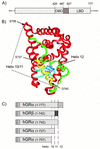
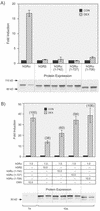
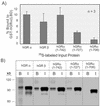
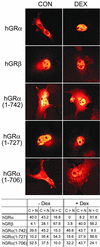
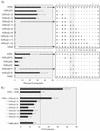
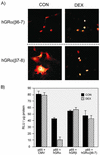
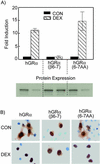
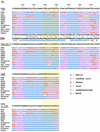

Similar articles
-
Human glucocorticoid receptor beta binds RU-486 and is transcriptionally active.Mol Cell Biol. 2007 Mar;27(6):2266-82. doi: 10.1128/MCB.01439-06. Epub 2007 Jan 22. Mol Cell Biol. 2007. PMID: 17242213 Free PMC article.
-
The dominant negative activity of the human glucocorticoid receptor beta isoform. Specificity and mechanisms of action.J Biol Chem. 1999 Sep 24;274(39):27857-66. doi: 10.1074/jbc.274.39.27857. J Biol Chem. 1999. PMID: 10488132
-
Pathologic human GR mutant has a transdominant negative effect on the wild-type GR by inhibiting its translocation into the nucleus: importance of the ligand-binding domain for intracellular GR trafficking.J Clin Endocrinol Metab. 2001 Nov;86(11):5600-8. doi: 10.1210/jcem.86.11.8017. J Clin Endocrinol Metab. 2001. PMID: 11701741
-
The physiology of human glucocorticoid receptor beta (hGRbeta) and glucocorticoid resistance.Ann N Y Acad Sci. 2006 Jun;1069:1-9. doi: 10.1196/annals.1351.001. Ann N Y Acad Sci. 2006. PMID: 16855130 Review.
-
Molecular mechanisms of glucocorticoid action and resistance.J Steroid Biochem Mol Biol. 2002 Dec;83(1-5):37-48. doi: 10.1016/s0960-0760(02)00263-7. J Steroid Biochem Mol Biol. 2002. PMID: 12650700 Review.
Cited by
-
Human glucocorticoid receptor beta binds RU-486 and is transcriptionally active.Mol Cell Biol. 2007 Mar;27(6):2266-82. doi: 10.1128/MCB.01439-06. Epub 2007 Jan 22. Mol Cell Biol. 2007. PMID: 17242213 Free PMC article.
-
Antiprogestin mifepristone inhibits the growth of cancer cells of reproductive and non-reproductive origin regardless of progesterone receptor expression.BMC Cancer. 2011 May 27;11:207. doi: 10.1186/1471-2407-11-207. BMC Cancer. 2011. PMID: 21619605 Free PMC article.
-
The Role of Chronic Stress in the Pathogenesis of Ischemic Heart Disease in Women.Compr Physiol. 2025 Feb;15(1):e70000. doi: 10.1002/cph4.70000. Compr Physiol. 2025. PMID: 39903543 Free PMC article. Review.
-
Usefulness of PBMCs to predict clinical response to corticosteroids in asthmatic patients.J Allergy Clin Immunol. 2012 Mar;129(3):687-693.e1. doi: 10.1016/j.jaci.2011.12.001. Epub 2012 Jan 10. J Allergy Clin Immunol. 2012. PMID: 22236730 Free PMC article.
-
Glucocorticoid Receptor Mutations and Hypersensitivity to Endogenous and Exogenous Glucocorticoids.J Clin Endocrinol Metab. 2018 Oct 1;103(10):3630-3639. doi: 10.1210/jc.2018-00352. J Clin Endocrinol Metab. 2018. PMID: 30020469 Free PMC article.
References
-
- Allgood, V. E., R. H. Oakley, and J. A. Cidlowski. 1993. Modulation by vitamin B6 of glucocorticoid receptor-mediated gene expression requires transcription factors in addition to the glucocorticoid receptor. J. Biol. Chem. 268:: 20870-20876. - PubMed
-
- Baldi, P., S. Brunak, P. Frasconi, G. Soda, and G. Pollastri. 1999. Exploiting the past and the future in protein secondary structure prediction. Bioinformatics 15:937-946. - PubMed
-
- Barroso, I., M. Gurnell, V. E. F. Crowley, M. Agostini, J. W. Schwabe, M. A. Soos, G. L. Maslen, T. D. M. Williams, H. Lewis, A. J. Schafer, V. K. K. Chatterjee, and S. O'Rahilly. 1999. Dominant negative mutations in human PPAR gamma associated with severe insulin resistance, diabetes mellitus and hypertension. Nature 402:880-883. - PubMed
-
- Bledsoe, R. K., V. G. Montana, T. B. Stanley, C. J. Delves, C. J. Apolito, D. D. McKee, T. G. Consler, D. J. Parks, E. L. Stewart, T. M. Willson, M. H. Lambert, J. T. Moore, K. H. Pearce, and H. E. Xu. 2002. Crystal structure of the glucocorticoid receptor ligand binding domain reveals a novel mode of receptor dimerization and coactivator recognition. Cell 110:93-105. - PubMed
MeSH terms
Substances
LinkOut - more resources
Full Text Sources
